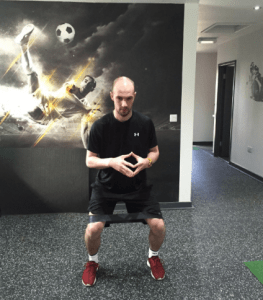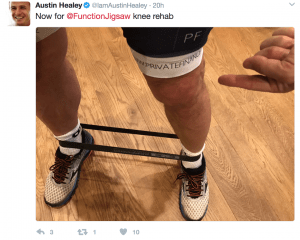Lauren Dobson examines the merits of improving hip and knee stability with our Active Bands
Are you currently suffering from any lower body instability problems? Do you prioritise reducing the risk of lower body injuries in your weekly training?
Did you know that improving hip mobility and strength can have a huge impact on your whole lower body’s stability when exercising?
When you train, it is important to work your hips through all ranges of motion and engage the hip abductors, adductors, gluteals and core muscles?
All of these muscle groups are crucial in providing hip and knee stability for any active individual.
If you only work the hips in one direction (forwards and back) by walking, running, cycling etc, there will be minimal strength and stability being formed through the lower body which is why common problems within these sports involve repetitive knee pain, achilles problems or ongoing lower back pain.

From using mini bands as warm-up routines to high intensity work out classes. Active Band exercises are very effective in improving hip and knee control.
Some exercises can look and can feel strange, but increasing strength in the hip stabiliser muscles; gluteals, hip abductors and core muscles is the key to reducing risk of injury or re-injury in all activities. Whether that activity may be strength training, endurance training, netball, football, rugby or whatever.
It’s simple and easy to do (sometimes).
The hip joint is a ball and socket joint which works at its best when it has good strength and a good range of movement. The knee is a hinge joint which flexes and extends the knee (bends knee and straightens knee). It is important to support and protect the knee from any movements other than this by strengthening and stabilising the joint and surrounding structures (above and below).
Short Active Band sessions
A weak glute medius muscle (one of the backside muscles on the side of the hip) has been known to cause knee instability problems especially injuries to specific structures such as the ACL.
A strong glute medius not only stabilises the hip, but helps maintain tracking in the knee joint by reducing lateral stress on the knee during functional motions.
Certain warm-up routines, such as a short Active Band sessions work effectively enough to activate and strengthen the glute muscles before training. This has proven to improve lower body stability if done correctly.
Once the correct structures are activated through this functional warm-up, the effects of a training session will be much more beneficial and target the intended structures of the body.
Lower body exercises to do with the Active Bands:
Crab walking/Lateral band walking
Clam/Side-lying hip abduction
Elevated hip bridges
Ski walks/Half-circle walks
These exercises emphasise training in correct movement patterns in preparation for functional movements such as running, jumping and landing, changing direction and acceleration/deceleration drills.
For the exercises to be effective, you need to choose the correct band strength, aim to progress in strengths and most importantly, keep it consistent and frequent.
Key things to remember:
Keep the band flat, not bunched.
Keep the band taut (feet shoulders width apart).
Keep your feet in line and facing forwards.
Maintain your intended position with the correct posture avoid tilting your hips sideways.
Stabilisers exercises
More advanced hip stabiliser exercises such as side plank, step-ups, walking lunges and single leg hip bridging can also be used to improve hip and knee control whilst training in conjunction with Active Band exercises.
Another important way of reducing the risk of injury and improving control when training for your sport, to be done alongside Active Band strengthening is to frequently stretch and Active foam roll structures such as glutes, hamstrings and hip flexors.
The majority of the population tend to focus on self-management techniques such as Active Foam Rolling once already injured or in pain. So why not reduce your risk of this from occurring and implement such things into your daily routine
Keeping these muscles mobile will also improve the mobility and the benefits of the Active Band training.
For more ways of reducing risk of injury and improving lower body stability, contact Function Jigsaw to book in with one of our sports therapists.
Read More: The science behind why Active Rollers work so well
Get involved: Buy Active Bands in our online shop









